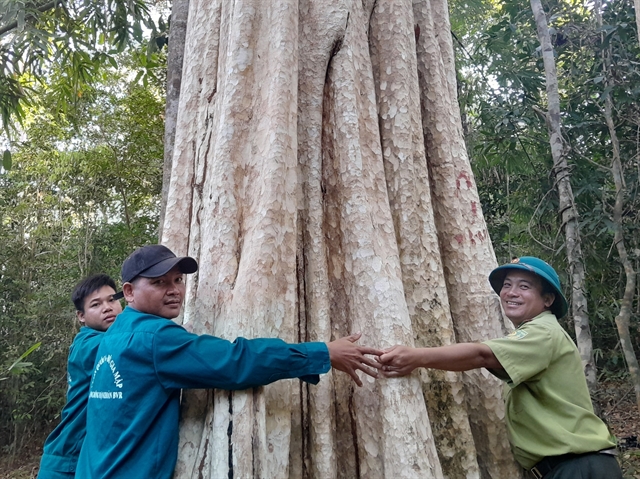 Economy
Economy

 |
| One of 39 trees aged 200-400 years in the Bù Gia Mập National Park in Bình Phước Province’s Bù Gia Mập District. They have been listed as heritage trees by the Việt Nam Association for Conservation of Nature and Environment. – VNA/VNS Photo |
BÌNH PHƯỚC – Bình Phước Province will expand the cultivation of timber forests to improve their value and growers’ incomes.
Under its plan to develop the forests in 2024 - 2030, the southeastern province aims to proactively provide timber to produce wooden products to serve domestic and export markets.
It aims to improve forest growers’ incomes, protect the environment, adapt to climate change, and mitigate the impacts of natural disasters.
To achieve the target, relevant agencies and localities with forests will take measures such as afforestation, forestry extension activities, and support policies.
They plan to develop linkages between various stakeholders for growing forests and inspect various areas to identify locations for growing large timber forests using intensive growing methods.
They will choose trees that grow fast and are indigenous to the areas, have high yields and quality and meet the market requirements.
They will instruct forest growers to adopt intensive growing techniques.
The province encourages the development of companies that are able to develop closed value chains for forest production and support farmers to plant forests meeting market requirements.
It will invest in infrastructure, especially roads in forests.
The province considered the green lung of the southeastern region, has more than 171,708 ha of zoned forestry lands, including 16,534ha that has yet to be afforested.
They comprise 31,179ha zoned as special-use forests, 43,548ha as protective forests and the rest as productive forests.
The province harvested 37,150 cubic meters of timber and 10,200 stores of firewood last year.
The target production by the wooden industry is VNĐ12.8 trillion (US$502 million) next year.
Forest protection
Bình Phước has performed the task of protecting forests well and has the potential for forest-related ecotourism.
The number of violations of forest protection regulations in 2017- 22 fell to 703 from 3,047 in 2011-16, according to the province’s Forest Protection Sub-department.
In the former period it also planted 1,144ha of new forests to achieve a forest cover of 22.6 per cent, up 1 per cent from 2016.
Many of its forests have huge potential for ecotourism due to their beautiful landscapes and heritage sites.
They include the Bù Gia Mập National Park, Bà Rá Mountain Historic and Culture Heritage Zone, Trảng Cỏ Bù Lạc Tourism Zone, and Đắk Mai Protective Forest.
Đắk Mai spreads over 6,700ha in Bù Gia Mập District bordering Cambodia, and is a buffer zone for the Bù Gia Mập National Park.
It is a vast untouched forest area with precious trees such as rosewood and redwood and herbal plants that are strictly protected.
Nguyễn Tiên Phong, director of its management board, said the forest has many advantages for developing ecotourism since it offers activities such as walking under the forest canopy, visiting the border and border markers, and travelling by river to watch ancient forests and rare bird species.
Its Đắk Mai waterfall is a beautiful sight. It is 50 metres wide and 10 meters high and visitors can walk to its top during the dry season.
The province has not given priority for developing forest tourism in past years, and forest tenders offer tourism services on their own and face difficulties such as a lack of professional human resources. – VNS